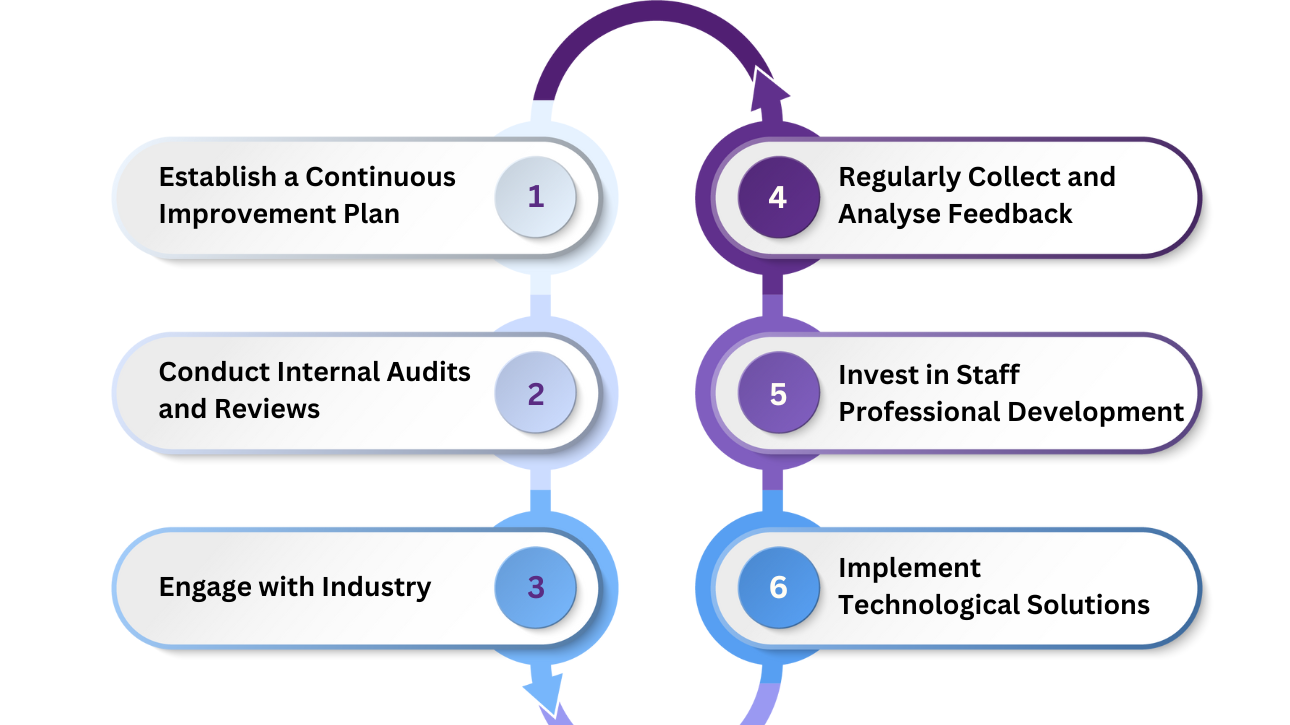✔️ How can your RTO stay ahead of the curve in the ever-evolving VET sector?
✔️ Are you prepared to implement continuous improvement strategies that ensure sustained excellence?
✔️ Discover how the draft revised standards can help you achieve and maintain high-quality training and assessment practices.
Introduction:
Continuous improvement is the lifeblood of a successful Registered Training Organisation (RTO). In a sector as dynamic as vocational education and training (VET), staying stagnant is not an option. The draft revised standards emphasise the importance of continuous improvement in ensuring high-quality training and assessment. In this blog, we’ll explore these updates and provide practical strategies to help your RTO implement and sustain a culture of continuous improvement.
Why Continuous Improvement Matters:
Incorporating continuous improvement into your RTO’s operations ensures that your training and assessment practices remain relevant, effective, and aligned with industry standards. The draft revised standards focus on continuous improvement to:

- Enhance Training Quality: Regularly updating training materials and methods to meet current industry needs.
- Increase Learner Satisfaction: Continuously improving services to meet the evolving expectations of learners.
- Ensure Compliance: Keeping up with regulatory changes and maintaining compliance with ASQA standards.
Key Areas of Continuous Improvement in the Draft Revised Standards:

- Feedback and Data Analysis:
- Collecting and analysing feedback from learners, trainers, and industry stakeholders to identify areas for improvement.
- Using data to make informed decisions about changes and enhancements.
- Regular Review of Training and Assessment Practices:
- Conducting regular reviews of training and assessment strategies to ensure they are effective and up-to-date.
- Incorporating new technologies and methodologies to improve delivery and outcomes.
- Professional Development for Staff:
- Ensuring trainers and assessors engage in ongoing professional development to stay current with industry trends and best practices.
- Providing opportunities for staff to enhance their skills and knowledge.
- Industry Engagement:
- Building strong partnerships with industry stakeholders to keep abreast of industry needs and developments.
- Using industry insights to shape and refine training programs.
Practical Strategies for Continuous Improvement:
To embed continuous improvement in your RTO’s operations, consider implementing the following strategies:

- Establish a Continuous Improvement Plan:
- Develop a formal continuous improvement plan that outlines objectives, actions, and timelines.
- Assign responsibilities to staff members to ensure the plan is executed effectively.
- Regularly Collect and Analyse Feedback:
- Use surveys, focus groups, and informal discussions to gather feedback from learners and staff.
- Analyse feedback to identify trends and areas for improvement.
- Conduct Internal Audits and Reviews:
- Schedule regular audits and reviews of training and assessment practices.
- Use the findings to make necessary adjustments and improvements.
- Invest in Staff Professional Development:
- Encourage and support trainers and assessors to participate in professional development activities.
- Provide access to relevant courses, workshops, and industry events.
- Engage with Industry:
- Establish advisory committees or working groups with industry representatives.
- Use their input to ensure your training programs are aligned with industry needs.
- Implement Technological Solutions:
- Explore and integrate new technologies that can enhance training delivery and learner engagement.
- Use learning management systems (LMS) and other digital tools to streamline processes and improve outcomes.
Practical Guide for RTOs: To ensure your RTO meets the continuous improvement requirements outlined in the draft revised standards, follow these practical steps:

- Establish a Continuous Improvement Plan: Develop a comprehensive plan with clear objectives, actions, and timelines.
- Engage Stakeholders: Involve learners, staff, and industry partners in the continuous improvement process to gather diverse perspectives.
- Monitor Progress: Regularly review and assess the impact of your continuous improvement initiatives to ensure they are achieving the desired outcomes.
- Adapt and Evolve: Be prepared to make changes based on feedback and data analysis to keep your RTO agile and responsive to new challenges.
Looking Ahead: This concludes our blog series on the draft revised standards for RTOs. However, we know that many questions may still remain. To address this, our next blog will be a comprehensive FAQ covering the most common questions about the draft revised standards. We aim to provide clarity and practical solutions to help your RTO navigate these changes confidently.
Stay tuned for Blog 6: “FAQs on the Draft Revised Standards for RTOs: Your Questions Answered”.
For further information on the draft revised standards, visit the Department of Employment and Workplace Relations’ Quality Reforms page.
Disclaimer:
The information presented on the VET Resources blog is for general guidance only. While we strive for accuracy, we cannot guarantee the completeness or timeliness of the information. VET Resources is not responsible for any errors or omissions, or for the results obtained from the use of this information. Always consult a professional for advice tailored to your circumstances.






